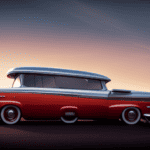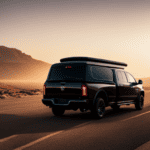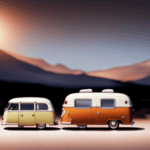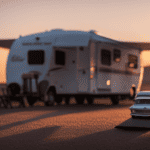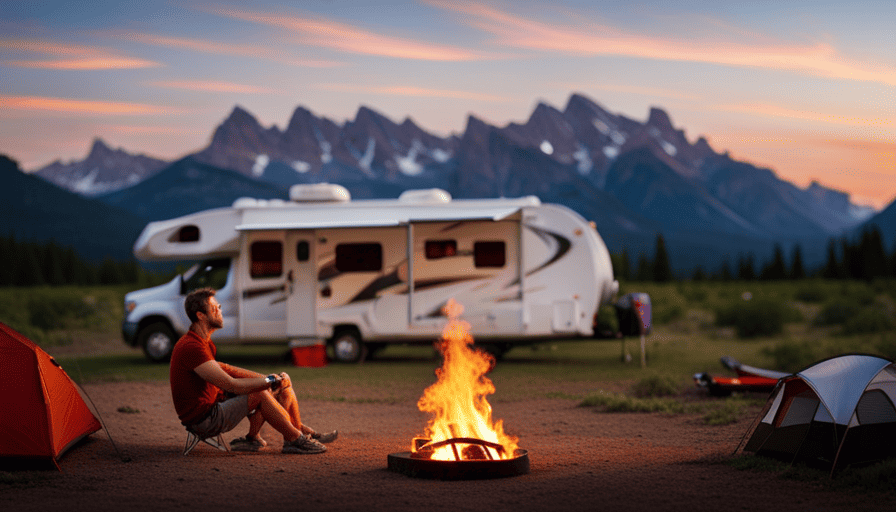Do you know that the weight of a truck bed camper can significantly impact your vehicle’s performance? It’s true! Understanding the weight of your camper is crucial for ensuring a safe and comfortable trip while on the road.
In fact, the weight of a truck bed camper can range anywhere from 1,000 to 5,000 pounds, depending on various factors such as size, construction materials, and amenities. Determining the exact weight of your camper is essential for matching it to your truck’s capabilities and avoiding any potential issues.
In this article, I will guide you through the process of weighing your truck bed camper, discuss the factors that contribute to its weight, and provide tips for reducing the weight if needed. Additionally, I will cover the legal requirements and safety precautions associated with carrying a heavy truck bed camper.
So, let’s dive in and find the perfect weight for your truck bed camper!
Key Takeaways
- Matching the weight of a truck bed camper to the capabilities of the truck is crucial for safety and performance.
- Exceeding the truck’s payload capacity can strain the suspension and brakes, leading to decreased acceleration and compromised handling.
- Weight distribution and construction materials of the camper impact stability and overall weight.
- It is important to consult manufacturer specifications, experts, and local regulations to ensure a safe and legal weight limit for the truck bed camper.
Understanding the Importance of Knowing the Weight of a Truck Bed Camper
You may be wondering why it’s essential for you to know the weight of a truck bed camper. Well, matching the camper weight to your truck’s capabilities is crucial for a safe and efficient journey. The weight of the camper can have a significant impact on your vehicle’s performance, including its handling, braking, and fuel efficiency.
When it comes to matching the camper weight to your truck, you need to consider the payload capacity of your vehicle. Exceeding this capacity can lead to excessive strain on the suspension and brakes, compromising your vehicle’s safety and longevity. Additionally, an overloaded truck may struggle to accelerate and maintain a steady speed, which can be dangerous on steep inclines or when overtaking.
Furthermore, the weight distribution of the camper is essential. Uneven distribution can cause instability and sway, affecting your ability to control the truck. It’s crucial to ensure that the weight is evenly distributed to maintain a balanced and stable ride.
Knowing the weight of a truck bed camper is vital for a hassle-free and safe travel experience. It allows you to make informed decisions and ensure that your truck can handle the load.
In the next section, we’ll explore the factors that contribute to the weight of a truck bed camper.
Factors That Contribute to the Weight of a Truck Bed Camper
When considering the weight of a truck bed camper, there are several factors that contribute to its overall weight. Firstly, the size and dimensions of the camper play a significant role. Larger campers tend to weigh more due to the increased materials and structural support required.
Secondly, the construction materials used can greatly impact the weight. Campers constructed with lightweight materials such as fiberglass or aluminum will be lighter compared to those made with heavier materials like wood or steel.
Lastly, the additional features and accessories added to the camper, such as slide-outs, awnings, or extra storage compartments, can also increase its weight.
Size and Dimensions of the Camper
The camper’s size and dimensions determine its weight. A larger camper with more square footage and higher ceilings will generally weigh more than a smaller one. This is because the materials used to construct the camper, such as wood, metal, and insulation, all contribute to its overall weight.
Additionally, the layout and design of the camper can also affect its weight distribution, which in turn impacts fuel efficiency. For example, a camper with a heavy front end may cause the truck to sag and decrease fuel efficiency. On the other hand, a camper with a well-balanced weight distribution can help maintain stability and improve fuel efficiency.
Moving on to the next section about construction materials used, it is important to consider their impact on the camper’s weight.
Construction Materials Used
Using lightweight materials for constructing a camper is like using feathers to build a floating oasis on wheels. By reducing weight, manufacturers can create campers that are easier to tow and more fuel-efficient. When it comes to choosing construction materials for truck bed campers, there are several lightweight options available. These materials offer durability and strength while keeping the overall weight of the camper low.
One popular lightweight option is fiberglass composite. This material is made by combining fiberglass with a plastic resin, resulting in a strong and lightweight structure. Another option is aluminum, which is known for its strength and corrosion resistance. Aluminum campers are lightweight and offer excellent durability.
To give you a better idea of the weight differences between these materials, here is a table comparing the average weight of a truck bed camper made from fiberglass composite and aluminum:
| Fiberglass Composite | Aluminum | |
|---|---|---|
| Average Weight | 800-1,500 lbs | 900-1,800 lbs |
By using these lightweight materials, manufacturers can create campers that are easier to tow and offer better fuel efficiency. Now, let’s move on to discussing additional features and accessories for truck bed campers.
Additional Features and Accessories
Imagine the convenience and added comfort you can experience with a range of additional features and accessories for your lightweight oasis on wheels. These enhancements not only make your truck bed camper more functional but also enhance your overall camping experience.
Here are three sub-lists of additional features and accessories that can take your truck bed camper to the next level:
-
Additional Storage Options:
- Rooftop cargo rack for extra gear and equipment
- Under-bed storage compartments for organizing camping essentials
- Overhead cabinets and shelves to maximize space utilization
-
Solar Power Systems:
- Solar panels for off-grid power generation
- Deep-cycle batteries for storing solar energy
- Power inverters to convert DC power to AC for charging electronic devices
By incorporating these additional features and accessories, you can transform your truck bed camper into a fully equipped mobile home. Now, let’s delve into how to determine the weight of a truck bed camper.
How to Determine the Weight of a Truck Bed Camper
When determining the weight of a truck bed camper, there are three key methods that can be utilized.
First, checking the manufacturer specifications is crucial as it provides accurate information about the camper’s weight.
Second, using a weighing scale or load cell allows for a precise measurement, ensuring accuracy when calculating the weight.
Lastly, consulting with experts or dealerships who specialize in truck bed campers can provide valuable insights and guidance in determining the weight.
By utilizing these methods, one can confidently assess the weight of a truck bed camper.
Checking Manufacturer Specifications
To get an idea of the weight of a truck bed camper, let’s take a peek at the manufacturer’s specifications. Checking the manufacturer’s information is one of the most reliable ways to determine the weight of a camper.
Manufacturers typically provide detailed specifications that include the weight of the camper, along with other important details such as dimensions, construction materials, and features. By looking at these specifications, you can get an accurate estimate of how much the camper weighs.
Additionally, the manufacturer’s specifications may also provide information on the construction materials used in the camper’s construction, allowing you to understand the pros and cons of different materials in terms of weight and durability.
Once we have gathered this information, we can move on to the next step of using a weighing scale or load cell to get a more precise measurement.
Using a Weighing Scale or Load Cell
Now, let’s see how you can use a weighing scale or load cell to get an accurate measurement of the weight of your truck bed camper. Using a weighing scale or load cell offers several benefits when it comes to determining the weight of your camper. Firstly, these devices provide precise and reliable measurements, ensuring accuracy in your calculations. Secondly, they are easy to use and can be conveniently placed under your camper for a quick and hassle-free weighing process. Additionally, weighing scales and load cells can handle heavy loads, making them suitable for measuring the weight of your truck bed camper.
To give you an idea of how this process works, here is a table showcasing the benefits of using weighing scales and load cells:
| Benefits | Weighing Scale | Load Cell |
|---|---|---|
| Accuracy | High | Very High |
| Ease of Use | Moderate | Easy |
| Weight Capacity | Moderate | High |
By utilizing a weighing scale or load cell, you can obtain an accurate weight measurement for your truck bed camper. This information is crucial when consulting with experts or dealerships for further guidance.
Consulting with Experts or Dealerships
Seeking advice from professionals or dealerships is a wise choice to ensure you make informed decisions about your truck bed camper. Consulting experts in the field will provide you with valuable insights on the weight considerations specific to your vehicle and camper combination.
These experts have extensive knowledge and experience in the industry, allowing them to offer accurate information regarding weight limits, towing capacities, and any modifications needed for your truck. Additionally, dealerships have the expertise to guide you through the process of selecting a camper that suits your needs while considering your vehicle’s capabilities.
By consulting with these professionals, you can make a well-informed decision that maximizes both safety and performance. Understanding the impact of camper weight on your vehicle’s performance is crucial, as it affects factors such as fuel efficiency, braking distances, and overall stability.
The Impact of Camper Weight on Your Vehicle’s Performance
Choosing a truck bed camper that’s too heavy can severely compromise your vehicle’s performance, creating a potentially dangerous situation. It’s crucial to consider the impact of camper weight on your truck’s fuel efficiency, handling, and maneuverability.
The weight of the camper directly affects how much fuel your vehicle consumes. A heavier camper increases wind resistance, resulting in decreased fuel efficiency. This means you may need to make more frequent stops at the gas station, adding to your overall expenses.
Additionally, the weight of the camper can affect your truck’s handling and maneuverability. A heavier camper can make your vehicle less responsive, especially when it comes to braking and cornering. It can also increase the risk of instability, making it more challenging to maintain control on uneven or winding roads.
Therefore, it’s crucial to match the weight of the camper to your truck’s capabilities to ensure optimal performance and safety on the road. Transitioning into the next section, it’s essential to explore how to properly match the weight of the camper to your truck’s capabilities.
Matching the Weight of the Camper to Your Truck’s Capabilities
Matching the weight of your camper to your truck’s capabilities is crucial for ensuring optimal performance and safety on the road. When considering a truck bed camper, it’s important to understand your truck’s limitations in terms of towing capabilities and camper capacity.
Here are four key factors to consider:
-
Gross Vehicle Weight Rating (GVWR): This is the maximum weight that your truck can safely carry, including both the vehicle itself and any additional load. It’s essential to choose a camper that falls within this weight limit to prevent overloading your truck.
-
Tongue Weight: This refers to the downward force exerted on the hitch of your truck when towing a camper. It’s important to match the tongue weight of the camper with your truck’s towing capacity to ensure stability and control while on the road.
-
Payload Capacity: This is the maximum weight that your truck’s bed can handle, including passengers, cargo, and the weight of the camper itself. Make sure that the combined weight of the camper and any additional load doesn’t exceed your truck’s payload capacity.
-
Towing Capacity: This is the maximum weight that your truck can tow safely. It’s crucial to choose a camper that falls within this towing capacity to prevent strain on your truck’s engine, transmission, and braking system.
Now that we understand the importance of matching the weight of the camper to your truck’s capabilities, let’s explore lightweight options for truck bed campers.
Exploring Lightweight Options for Truck Bed Campers
When it comes to lightweight options for truck bed campers, there are a few key points to consider.
Firstly, pop-up campers and folding trailers are great choices as they’re designed to be compact and lightweight, making them easy to tow and maneuver.
Secondly, campers constructed with fiberglass and aluminum materials offer a lightweight yet durable option, ensuring longevity and ease of use.
Lastly, compact and minimalist designs are popular among lightweight truck bed campers, maximizing space efficiency without sacrificing comfort.
Pop-Up Campers and Folding Trailers
To get the most out of your camping adventures, you should consider the weight of a truck bed camper if you opt for a pop-up camper or folding trailer. Pop-up campers are a popular choice among truck owners due to their lightweight construction and easy setup. They are typically lighter than hard-sided campers, making them more fuel-efficient and easier to tow. However, they may lack some of the amenities and space that hard-sided campers offer.
Folding trailers, on the other hand, provide a good balance between weight and comfort. They are lightweight when folded, but expand to offer more living space when parked. The main advantage of folding trailers is their compact size and ability to be towed by smaller vehicles.
Now, let’s move on to the next section about fiberglass and aluminum construction.
Fiberglass and Aluminum Construction
Fiberglass and aluminum construction can offer campers a lightweight and durable option for their camping adventures. When it comes to choosing between fiberglass and aluminum, both materials have their pros and cons.
Fiberglass is known for being lightweight, which is beneficial for fuel efficiency and ease of towing. It also provides better insulation and is less prone to denting.
On the other hand, aluminum is more durable and resistant to damage from impact. It’s also easier to repair in case of any damage.
When considering weight distribution and stability, it’s important to note that fiberglass campers tend to have a lower center of gravity, which enhances stability on the road.
As we transition to the next section on compact and minimalist designs, it’s worth noting that both fiberglass and aluminum construction can lend themselves well to these types of campers.
Compact and Minimalist Designs
Compact and minimalist designs can be a popular choice among campers, with some models measuring as small as 10 feet in length. These compact campers offer numerous benefits, such as improved fuel efficiency and maneuverability. Despite their smaller size, they often come equipped with essential features, including a comfortable sleeping area, a small kitchenette, and storage space. To emphasize the advantages of compact and minimalist designs, consider the following table:
| Compact Design Benefits | Minimalist Camper Features | Enhanced Fuel Efficiency |
|---|---|---|
| Easy to tow | Lightweight construction | Aerodynamic shape |
| Maneuverability | Space-saving design | Efficient engine |
| Parking flexibility | Simplified interior | Reduced wind resistance |
These features contribute to a lighter overall weight, making it easier to tow and reducing strain on the truck. Speaking of weight reduction, let’s explore some tips for reducing the weight of your truck bed camper without compromising functionality or comfort.
Tips for Reducing the Weight of Your Truck Bed Camper
Did you know there are some simple tricks you can use to lighten the weight of your truck bed camper? When it comes to reducing camper weight, there are several lightweight camper options and strategies that can make a significant difference.
Here are some tips to help you achieve a lighter camper:
-
Opt for lightweight materials: Consider using lightweight materials such as aluminum or fiberglass for the camper shell. These materials are strong and durable, yet much lighter than traditional materials.
-
Minimize unnecessary features: Evaluate the accessories and features in your camper and eliminate any that aren’t essential. This will help reduce the overall weight and increase fuel efficiency.
-
Choose compact appliances: Look for compact and lightweight appliances for your camper, such as a smaller fridge or stove. This will significantly reduce the weight without compromising functionality.
By following these tips, you can significantly reduce the weight of your truck bed camper and make it more efficient to tow.
Now, let’s move on to discussing some important safety precautions for carrying a heavy truck bed camper.
Safety Precautions for Carrying a Heavy Truck Bed Camper
To ensure a safe and enjoyable journey, it’s important to take proper safety precautions when carrying a heavy camper in the back of your truck.
One of the key factors to consider is the carrying capacity of your truck. Each truck has a specific weight limit that it can safely handle, which includes the weight of the camper and all its contents. Exceeding this limit can put unnecessary strain on your vehicle and compromise its stability on the road.
Weight distribution is another crucial aspect to focus on. It’s essential to distribute the weight evenly across the truck bed to maintain balance and prevent excessive strain on the suspension system. This can be achieved by properly positioning the camper and securing it with appropriate tie-downs or straps.
Additionally, it’s advisable to use a weight distribution hitch system to evenly distribute the weight between the front and rear axles of your truck, further enhancing stability.
By adhering to these safety precautions, you can ensure that your truck bed camper is carried safely and securely. However, it’s important to note that legal requirements and regulations for truck bed camper weight vary by jurisdiction. So, it’s essential to familiarize yourself with the specific rules and regulations in your area to avoid any legal issues.
Legal Requirements and Regulations for Truck Bed Camper Weight
Ensure that you familiarize yourself with the legal requirements and regulations in your area for the weight of your truck bed camper, so you can avoid any potential legal complications and embark on your journey with peace of mind.
It’s crucial to understand the factors that affect the weight of a truck bed camper. These factors include the materials used in its construction, the size and design of the camper, and the amenities and features it offers. Additionally, the weight of the truck itself and the towing capacity of your vehicle also play a significant role in determining the maximum weight of the camper.
To help you navigate through this process, here are some key legal requirements and regulations for towing a truck bed camper:
-
Ensure that the weight of your truck bed camper does not exceed the maximum weight specified by your vehicle manufacturer or the legal limit set by your local authorities.
-
Make sure that your camper is securely attached to your truck and that all safety measures, such as proper hitching, chains, and braking systems, are in place.
-
Check if you need any additional permits or licenses to tow a camper of a certain weight in your area.
-
Keep in mind that exceeding the legal weight limit can result in fines, penalties, and even restrictions on your driving privileges.
Understanding and adhering to these legal requirements will ensure a safe and hassle-free journey.
In the next section, we’ll discuss finding the perfect weight for your truck bed camper.
Conclusion: Finding the Perfect Weight for Your Truck Bed Camper
When determining the ideal weight for your truck bed camper, remember that prioritizing safety and following legal regulations will provide you with peace of mind and allow you to enjoy your journey without any worries. It is crucial to match the weight of your camper to your truck’s capabilities to ensure optimal performance on the road.
When considering the weight of your truck bed camper, it is essential to understand the impact it will have on your vehicle’s performance. Exceeding your truck’s weight capacity can lead to decreased acceleration, reduced braking efficiency, and compromised handling. Additionally, an overloaded truck can put excess strain on the suspension, tires, and brakes, potentially leading to costly repairs and safety hazards.
To determine the perfect weight for your truck bed camper, consult your truck’s manufacturer specifications and adhere to the legal requirements and regulations outlined by your local authorities. These guidelines will help you ensure that your camper is within the safe weight limits for your specific truck model.
To further assist you in finding the right weight for your truck bed camper, refer to the table below:
| Truck Model | Maximum Towing Capacity | Maximum Payload Capacity |
|---|---|---|
| Ford F-150 | 13,200 lbs | 3,270 lbs |
| Chevrolet Silverado 1500 | 13,300 lbs | 2,280 lbs |
| Toyota Tacoma | 6,800 lbs | 1,440 lbs |
By understanding your truck’s capabilities and considering the impact on its performance, you can confidently choose a camper that matches your needs while ensuring a safe and enjoyable journey.
Frequently Asked Questions
What are the legal requirements and regulations for the weight of a truck bed camper?
As an expert in truck bed campers, I can provide detailed information on the legal requirements and weight regulations.
When it comes to truck bed campers, there are specific legal requirements and regulations that must be followed. These regulations vary depending on the jurisdiction, but generally, they include maximum weight limits, axle weight limits, and overall vehicle length restrictions.
It’s crucial to adhere to these regulations to ensure safety on the road and avoid any legal complications.
What are some safety precautions to consider when carrying a heavy truck bed camper?
When carrying a heavy truck bed camper, it’s crucial to follow proper tie-down techniques to ensure its stability and safety. Use high-quality straps or chains to secure the camper tightly to the truck bed, minimizing movement during transit.
Additionally, consider upgrading your vehicle’s suspension system to handle the added weight. Suspension enhancements, such as heavy-duty shocks or airbags, can improve stability and control, reducing the risk of accidents or damage to your camper or truck.
Are there any lightweight options available for truck bed campers?
When it comes to finding a camper that won’t weigh you down, there are plenty of lightweight options available. Some of the best lightweight camper brands on the market offer innovative designs and materials that maximize space while minimizing weight.
From fiberglass shells to aluminum frames, these campers are engineered to be light yet durable. So, if you’re looking for a camper that won’t be a burden on your truck, consider exploring the world of lightweight camper options.
How can I reduce the weight of my truck bed camper?
To reduce the weight of your truck bed camper, there are several options available. Firstly, consider replacing heavy materials with lightweight alternatives. For example, you can use fiberglass or aluminum instead of wood. Additionally, you can opt for lightweight appliances and fixtures and avoid unnecessary additions. You can also install a solar power system to eliminate the need for heavy batteries. Lastly, selecting a lightweight camper option from the market can also help in reducing overall camper weight.
How does the weight of a camper impact a vehicle’s performance?
The weight of a camper has a significant impact on a vehicle’s performance. The added weight affects acceleration, braking, and handling.
With a heavier camper, the vehicle’s engine may have to work harder to maintain speed, resulting in decreased fuel efficiency. Braking distances are also increased due to the additional weight. Handling may become more difficult, especially in turns or windy conditions.
Therefore, it’s crucial to consider the camper weight when assessing a vehicle’s performance capabilities.
Is a Truck Bed Camper Heavier Than a Teardrop Camper?
Yes, a truck bed camper is usually heavier than a teardrop camper. The teardrop camper weight is generally lighter due to its smaller size and streamlined design. In comparison, truck bed campers tend to have more amenities and extra features, which contribute to their increased weight.
Conclusion
As I wrap up my exploration of the weight of a truck bed camper, I’m reminded of the delicate balance between functionality and efficiency. Just like a tightrope walker skillfully navigates their path, finding the perfect weight for your camper requires precision and finesse.
By understanding the factors that contribute to the weight and determining the impact on your vehicle’s performance, you can achieve a harmonious symbiosis. Matching the weight to your truck’s capabilities is crucial.
Remember, weight isn’t just a number, but a symbol of harmony and optimal performance on your camping adventures.






